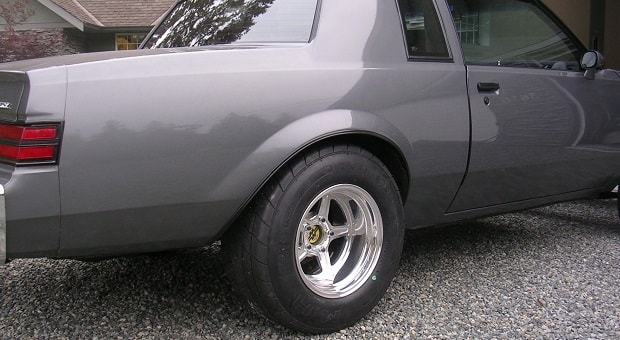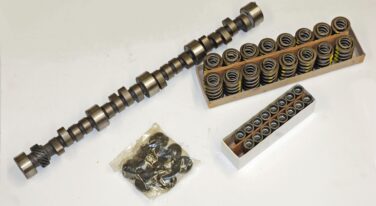
Wheel Studs and Lug Nuts, Hooray! Part 2
Click Here to Begin Slideshow
Last issue, we introduced you to several different wheel stud formats. We ended with a look at the best system available for a drag car: the drive stud. This time around we’ll explain how to figure out which stud fits what application and which washers to use for your application. Here’s how it works:
What gets confusing for a lot of racers - even Pro racers have been baffled by the combinations - is the number of different combinations of stud lengths and washer thicknesses available. Mark Williams offers a number of different washer sizes and stud lengths (the drive shoulder length of the stud differs). The reason for the multitude of combinations is the range of wheel center thickness on the market, coupled with the actual thickness of the brake drum or disc brake hat and a wheel spacer (if one is used). According to Mark Williams, the most important factor when choosing the proper stud is that the driving portion of the stud is fully engaged into the wheel. The smooth "drive" segment dimension of the stud needs to be slightly greater than the combined thickness of the brake adapter/drum and the thickness of the wheel. Meanwhile, the washer thickness should be greater than the shoulder extending past the wheel. When ordering a set of drive studs, you must specify the wheel center and brake hat (or brake drum) thickness.
In conjunction with their drive stud system, MW has developed a reduced hex (7/8") "Base Nut" series for use with the drive stud wheel retention system. The "Base Nuts" are produced in both 17-4 stainless steel and titanium alloy. The aluminum spacer washer attaches with a snap fit over the base nut; the washer spins freely, but will not separate from the nut, which in turn prevents marring of the wheel surface. This also eliminates the problem of losing the washers when swapping tires. The washer is available in different thickness (1/8" to 3/4") to compensate for different wheel and brake hat thickness. The washers can be changed if the wheel thickness changes. By using stainless steel and titanium alloys, rust or corrosion problems are obviously eliminated. These nuts are either produced on CNC machines from bar material or are forged. This makes the nut a dimensionally (and visually) superior component. Because of the manufacturing method, the thread pitch diameter is extremely square with the flange. This produces an even grip pressure load on both the wheel and the stud.
What if you're weight conscious? You can use drive studs manufactured from titanium alloy. As an example, Mark Williams manufactures drive studs machined from the lightweight material. These titanium studs are manufactured from Ti-17 material with a tensile strength of 180 KSI and a Rockwell hardness of 40. In comparison to a comparable chrome moly stud, the titanium piece actually features a higher tensile strength. Typically, a set of titanium studs can save approximately 1.625 pounds over a set of their conventional drive studs, but be prepared to pay for the weight loss. Titanium isn't cheap (nor is it easy to machine). As a result, titanium studs can increase the cost factor by well over one hundred dollars. Remember though, that unsprung, rotating mass is much more critical than just weight.
In addition to titanium studs, Mark Williams has also developed a set of "encapsulated" aluminum series lug nuts. Obviously, they're designed for applications where every ounce of weight is critical. The part is produced from 7075 aluminum alloy with a hard coat finish. The stainless steel washer spins freely, but will not separate from the nut. The nut has a fixed counter bore depth that is equivalent to using the standard nut/washers in combinations in the 1/8" and 3/8" thickness. The washer snap-fits on the nut to prevent accidental loss and is manufactured from rust proof stainless steel material.
As you can see, lug nuts and wheel studs are components that should not be taken lightly. More than one car has been mortally wounded simply because the owner turned into Scrooge on elementary hardware such as this. In the photos that follow, you'll find a selection of different stud and nut combinations, along with information on how to determine the right wheel stud/lug nut mix for your racecar.
Last issue, we introduced you to several different wheel stud formats. We ended with a look at the best system available for a drag car: the drive stud. This time around we’ll explain how to figure out which stud fits what application and which washers to use for your application. Here’s how it works:
What gets confusing for a lot of racers - even Pro racers have been baffled by the combinations - is the number of different combinations of stud lengths and washer thicknesses available. Mark Williams offers a number of different washer sizes and stud lengths (the drive shoulder length of the stud differs). The reason for the multitude of combinations is the range of wheel center thickness on the market, coupled with the actual thickness of the brake drum or disc brake hat and a wheel spacer (if one is used). According to Mark Williams, the most important factor when choosing the proper stud is that the driving portion of the stud is fully engaged into the wheel. The smooth "drive" segment dimension of the stud needs to be slightly greater than the combined thickness of the brake adapter/drum and the thickness of the wheel. Meanwhile, the washer thickness should be greater than the shoulder extending past the wheel. When ordering a set of drive studs, you must specify the wheel center and brake hat (or brake drum) thickness.
In conjunction with their drive stud system, MW has developed a reduced hex (7/8") "Base Nut" series for use with the drive stud wheel retention system. The "Base Nuts" are produced in both 17-4 stainless steel and titanium alloy. The aluminum spacer washer attaches with a snap fit over the base nut; the washer spins freely, but will not separate from the nut, which in turn prevents marring of the wheel surface. This also eliminates the problem of losing the washers when swapping tires. The washer is available in different thickness (1/8" to 3/4") to compensate for different wheel and brake hat thickness. The washers can be changed if the wheel thickness changes. By using stainless steel and titanium alloys, rust or corrosion problems are obviously eliminated. These nuts are either produced on CNC machines from bar material or are forged. This makes the nut a dimensionally (and visually) superior component. Because of the manufacturing method, the thread pitch diameter is extremely square with the flange. This produces an even grip pressure load on both the wheel and the stud.
What if you're weight conscious? You can use drive studs manufactured from titanium alloy. As an example, Mark Williams manufactures drive studs machined from the lightweight material. These titanium studs are manufactured from Ti-17 material with a tensile strength of 180 KSI and a Rockwell hardness of 40. In comparison to a comparable chrome moly stud, the titanium piece actually features a higher tensile strength. Typically, a set of titanium studs can save approximately 1.625 pounds over a set of their conventional drive studs, but be prepared to pay for the weight loss. Titanium isn't cheap (nor is it easy to machine). As a result, titanium studs can increase the cost factor by well over one hundred dollars. Remember though, that unsprung, rotating mass is much more critical than just weight.
In addition to titanium studs, Mark Williams has also developed a set of "encapsulated" aluminum series lug nuts. Obviously, they're designed for applications where every ounce of weight is critical. The part is produced from 7075 aluminum alloy with a hard coat finish. The stainless steel washer spins freely, but will not separate from the nut. The nut has a fixed counter bore depth that is equivalent to using the standard nut/washers in combinations in the 1/8" and 3/8" thickness. The washer snap-fits on the nut to prevent accidental loss and is manufactured from rust proof stainless steel material.
As you can see, lug nuts and wheel studs are components that should not be taken lightly. More than one car has been mortally wounded simply because the owner turned into Scrooge on elementary hardware such as this. In the photos that follow, you'll find a selection of different stud and nut combinations, along with information on how to determine the right wheel stud/lug nut mix for your racecar.


![[Gallery] Show us Your Mustang! Celebrating 60 Years of Mustang](https://www.racingjunk.com/news/wp-content/uploads/2024/04/Al-Liebmann-376x206.webp)

![[Gallery] Okolona Street Rods Kentuckiana V Foundation Car Show](https://www.racingjunk.com/news/wp-content/uploads/2022/04/IMG_0774-e1650040587750-376x206.jpg)
![[Gallery] Road Rats Car Show](https://www.racingjunk.com/news/wp-content/uploads/2022/05/2A-e1651770667920-376x206.jpg)
Thank you for this article, I am in the process of building a 1959 GMC Grumman Curbside, by luck one of my very best friends had a 1973 GMC Suburban 2500. He had a 396 big block balanced and blueprinted making 625 HP. I didn’t really need the horsepower, but the price was right. My need is I installed a 2000 GM rear disk brake rear end, 1964 6 lug front disk brake rotors in front. I have a set of Cadillac wheels I want on this build. With this information you have given me an answer I have not found in a lot of searches. Thank you So very much.